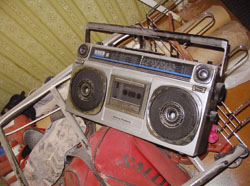 |
|
|
THE NATURE OF ARCHITECTURE NOERDLINGEN WHAT IS DANCE? HARRY PYE’s POSTCARD FROM LONDON THEATRE IS REALITY, FILM IS ILLUSION MY LIBRARY FASHION AND LIFE ILLUMINATING THE SHADOW WITHOUT DAZZLING IT |
Illuminating the shadow without dazzling it – musical essence in portray-photography
This poetic definition, as it can be found in the very first music theories, affirms that the essence of music lies in the inherent antinomy between the simultaneously sounding real single note/chord and its gradual narrative dimension within the abstract entity. What am I talking about? I’m trying to describe the phenomenon of a sign that makes sense only after it has disappeared, and that at the same moment gives sense to the following sign (like for instance in a c major scale, where the note will create a strong tension that will be resolved by the note c). Present transition could be the key term for this essence: the presence of the acoustic waves in the air transformed into a sound by the human brain, but transitory as it evaporates into the stream of waves, so to say. The concert began, the ensemble played modern atonal chamber music as I had more or less expected. Apart from the different dynamic curves, both melodic and rhythmic, I didn’t really understand what was supposed to give structure to the composition – although I was intrigued by the intensity of the rests literally played by each musician. It might seem esoteric, but they didn’t sound like simple, mute pauses; instead, these moments were palpable, swinging silences, at the edge of the two aesthetics tenses. And inevitably, my uncomprehending, reactive listening of the music changed into a creative perception of something that was beyond oppositions and structures.
The silence. Not a gap, even less a void. Instead, a very living time-space in which all the tenses – past, present, and future – are equally valid. This time-space manifests itself in an in-between-moment that doesn’t necessarily call for a conflict to “organize” the relation between the various elements, but that instead surmounts the original difference by making coexistence possible. And if there is a mutual definition between the single elements as mentioned before, no fusion or dominance between them is required to avoid a clash. This is not a utopian paradise; this is the very real moment in which music emerges out of sounds! After a short break, the programme went on with a piece for trumpet and five tape-recorders. Yes, five analogue tape recorders, like the one you used to have in your child’s room to listen to some spooky radio plays, were used as instruments! With different scores put on music stands. Call it intellectual self-gratification (I won’t mention the name Walter Benjamin, I won’t) – what happened now was probably the most intense moment of the whole night: The trumpet performed a melody while the recorders played silent noise (due to the recording modus or to the virginity of the tape), alternately interrupting this playing (creating quick and abrupt sounds) to rewind and replay themselves! So that the composition developed out of itself, far from being a simple multi-loop, but rather a manifest of the highly unique and still fundamental (re)creation of music; as if it had become possible to express the unspeakable, to illuminate the shadow of the musical essence without dazzling it. Ever since I’ve been looking at portray photographs that speak to me (and furthermore in some situations where I myself have been photographing persons), I have this vague impression of harmony so hard to define that now, in the moment where I am writing this text, appears very familiar to what has been described above. If there is something specific (but not exclusive) to music, an essence, then why shouldn’t it manifest in other forms of art? I’m not talking about self-reproduction; I’m talking about time and space. The relation established through the camera can (not necessarily has to) allow this type of equality. Of course there is a behind and an in front of the camera, someone giving a frame to another. But what I’ve tried to develop in this article is a concept of equality that is not limited to a pure similarity: instead, what this contemporary music concert made me realize is that through the time-space within the silence, and (in that perception) also through the act of photographing, transient presence is possible. Maxime Stoecker Maxime Stoecker is an elaborative collector of 7” singles of musicians of formerly unknown origin. He is pursuing his master in comparative literature in Berlin and Montréal, taking portraits of musicians, comic artists and friends and plays the clarinet in La Guerre des Tuques. |

 What a surprisingly confirming next oeuvre they played! It was a silent choreography, the musicians dancing with their instruments through the room, declining almost permeable movements on an invisible path. Their arms and legs were developing pictorial yet evasive sentences, silent melodies that looked like variations on a dreamt theme. How natural and harmonic it was, how musical. Not a single note had to be played, as it was all there, within the inhabited silence.
What a surprisingly confirming next oeuvre they played! It was a silent choreography, the musicians dancing with their instruments through the room, declining almost permeable movements on an invisible path. Their arms and legs were developing pictorial yet evasive sentences, silent melodies that looked like variations on a dreamt theme. How natural and harmonic it was, how musical. Not a single note had to be played, as it was all there, within the inhabited silence.